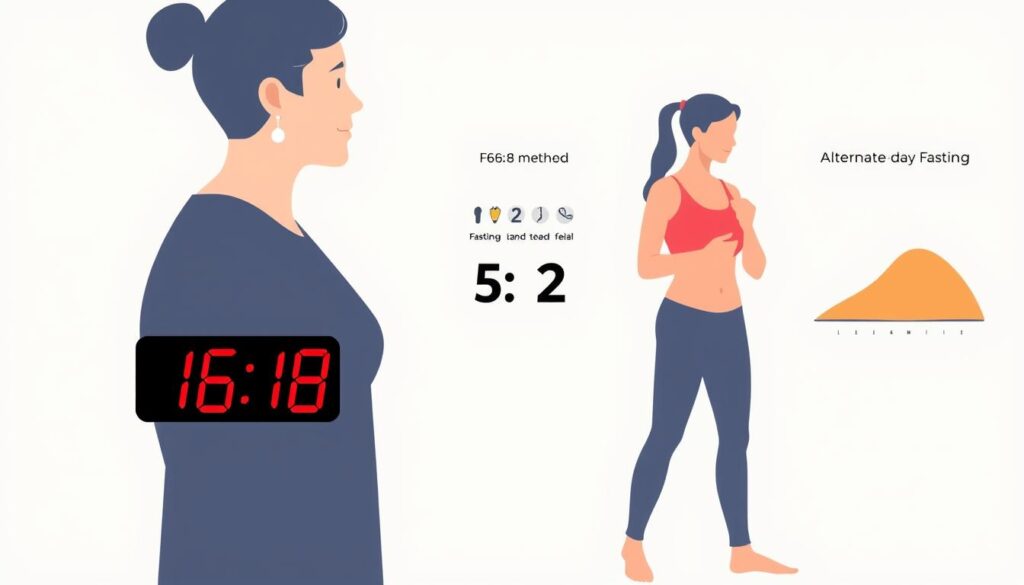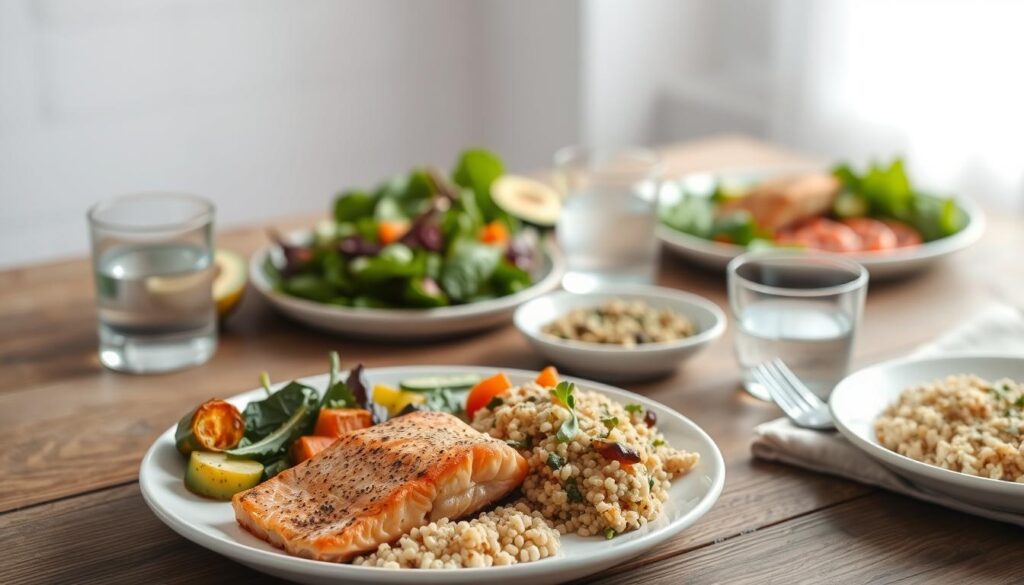Intermittent Fasting for Effective Weight Loss.
Unlock the secrets of intermittent fasting for weight loss and discover effective strategies to shed pounds and improve health.
Ever look for a big change? I did, wanting to be healthier and lighter. I found intermittent fasting, and it changed my life!
It's not just about losing weight. It's about feeling full of energy and clear-headed too. This way of eating changes how you feel and look.
Imagine not worrying about every meal. You just follow a simple fasting and eating schedule. It's easy and works wonders for your health. Try it and see the amazing changes for yourself!
Key Takeaways
- Intermittent fasting focuses on when to eat, not what to eat.
- It can help achieve effective weight loss without extreme diets.
- Fasting periods can boost energy levels and mental clarity.
- Simple and easy to integrate into everyday life.
- Promotes overall health and well-being.
What is Intermittent Fasting?
Are you curious about the buzz around intermittent fasting? Let's explore this topic. It can change your health journey. But first, what is intermittent fasting?
Definition and Overview
Intermittent fasting is an eating plan. You cycle between eating and fasting. It focuses on when you eat, not what.
There are many ways to do it. The 16/8 method means eating for eight hours and fasting for sixteen. The 5:2 diet lets you eat normally for five days and less for two. It helps your body burn fat after using up sugar.
Historical Background
Intermittent fasting has roots in human history and religion. Humans used to go without food, relying on fat for energy. This shows it's part of our biology.
Mark Mattson has studied it for over 25 years. His work shows it's good for weight loss and brain health. For more info, check out this Johns Hopkins article.
How Intermittent Fasting Works
Ever wondered how intermittent fasting helps with weight loss? It's because of cool tricks our bodies do when we don't eat. Let's explore the science behind it.
Metabolic Switching
Why do people love intermittent fasting for losing weight? It's because of metabolic switching. Our bodies usually use glucose for energy. But when we fast, we use up glucose and start burning fat instead.

This change is more than just for losing weight. It also helps control blood sugar and makes insulin work better. It's like your body is burning fat more efficiently, thanks to fasting!
Cellular and Hormonal Changes
Fasting does more than just burn fat. It also changes what's happening inside your body. When you fast, your cells clean themselves by getting rid of damaged parts. This makes your cells work better.
And hormones play a big role too. Fasting makes your growth hormone levels go up, helping you lose fat and gain muscle. Also, insulin levels go down, making it easier to burn stored fat. The best fasting schedule doesn't just slim you down; it makes your whole body better.
These changes show why fasting is more than a trend. It's a lasting, science-backed way to get healthier and feel great.
Benefits of Intermittent Fasting
Ever wondered about intermittent fasting's real benefits? Let's explore how it can change your health and wellbeing.
Weight Loss and Fat Reduction
One big intermittent fasting benefit is losing weight. It works by using fat for energy when you eat less. This keeps your muscles strong while you lose fat. It's a great deal! 😉
Improved Heart Health
Intermittent fasting also helps your heart. It can lower blood pressure and bad cholesterol. This makes your heart healthier. Who doesn't want a healthy heart? ❤️
Enhanced Brain Function
Now, let's talk about your brain. Intermittent fasting makes your brain work better. It improves memory and thinking. You might feel smarter and more alert on your next intermittent fasting meal plan.

Intermittent Fasting for Weight Loss
Have you ever wondered why people talk about intermittent fasting for weight loss? It's simple but works well. By changing when we eat, we eat fewer calories. This small change can make a big difference.
When we fast, our body burns more calories. Also, our body's hormones change in a good way. This helps us use fat better. These changes can help us lose weight over time.
Here are some intermittent fasting tips:
- Stay hydrated to feel less hungry.
- Start with longer eating times if you're new.
- Eat foods rich in nutrients to keep your energy up.
If you want to lose weight easily, try intermittent fasting. It's not just about eating less. It's about eating at the right times and making the most of your meals!
Types of Intermittent Fasting Schedules
Starting with intermittent fasting can feel scary. But, finding the right schedule makes it easier. Let's explore three popular intermittent fasting types that are easy and work well.
16/8 Method
The 16/8 method is easy to start with. It means you eat only for eight hours a day. For example, if you eat your first meal at 11 AM, you can eat until 7 PM.
I found this schedule gave me more energy. It also kept me from feeling too hungry. It's great for beginners because it fits well into most daily routines.
5:2 Diet
The 5:2 diet is good for beginners. You eat normally for five days and then eat very little on the other two days. You can choose which days to eat less, making it easy to follow.
24-Hour Fasts
For a bigger challenge, try a 24-hour fast. This means not eating for 24 hours, once or twice a week. It was hard at first, but it helped me feel more energetic and clear-minded.

| Intermittent Fasting Type | Eating Window | Difficulty Level | Best For |
|---|---|---|---|
| 16/8 Method | 8-hours | Easy | Intermittent Fasting for Beginners |
| 5:2 Diet | 2 days per week | Moderate | Flexible Schedules |
| 24-Hour Fasts | Once or twice a week | Hard | Advanced Practitioners |
Intermittent Fasting Meal Plans
Making a good intermittent fasting meal plan is key to getting the most out of this diet. We'll explore some examples and important nutrition tips to help you start right.

Example Meals
Choosing healthy, balanced meals during your eating time is important. This ensures you get the best intermittent fasting results. Here's what your day could look like:
Breakfast:
- Scrambled eggs with spinach and avocado
- Whole-grain toast
- Fresh berries
Lunch:
- Grilled chicken salad with mixed greens, cherry tomatoes, and olive oil dressing
- Quinoa pilaf
- Greek yogurt
Dinner:
- Baked salmon with roasted vegetables
- Brown rice
- Steamed broccoli
Macro and Micronutrient Focus
It's important to balance macronutrients like proteins, fats, and carbs. Also, don't forget about vitamins and minerals. Here's what to remember:
- Protein: It helps muscles repair and grow. Eat lean meats, beans, and legumes.
- Healthy Fats: They're good for your brain and hormones. Include olive oil, nuts, and fatty fish.
- Fiber: It helps with digestion and keeps you full. Eat fruits, veggies, and whole grains.
Adding these nutrients to your intermittent fasting meal plan will help you get the best intermittent fasting results. This ensures a balanced and satisfying diet.
Intermittent Fasting and Exercise
Doing intermittent fasting and exercise together can help you lose fat and keep muscle. It's important to time your workouts right. This helps your body handle the exercise while fasting.
Timing of Workouts
Timing your exercise is key for the benefits of intermittent fasting. Working out after waking up or soon after is best. This is true for a 16 to 18-hour fast.
It helps burn fat and keep muscle. Also, wait two to three hours after working out to eat. This boosts growth hormone levels. It helps burn fat and refill energy.

Type of Exercises
The kind of exercises you do matters too. Light to moderate exercises like cardio or strength training are good. They help your metabolism without stressing your fasting body.
HIIT and sprint training are great. They boost human growth hormone (HGH). This can improve your body, increase stamina, and reduce depression.
Lifting weights is okay during fasting, but eat right after heavy lifting. Mixing up your workouts can make fasting and exercise better. But, listen to your body and change your routine as needed.
Intermittent Fasting Tips
Intermittent fasting can change your life for the better. But, how do you stick to it? Here are some tips to help you.
Staying Hydrated
Drinking water is key. It keeps you full and gives you energy. Zero-calorie drinks like herbal teas are good too.
Staying hydrated is very important. It helps you feel less hungry and keeps you from getting dehydrated.
Dealing with Hunger
It's hard to ignore hunger, but you can do it. Eating foods rich in fiber helps you feel full. Try almonds, chickpeas, and leafy greens.
Mindful eating is helpful. Think about the good things you're doing, not what you can't eat. It's all about your mindset.
Starting out with intermittent fasting for weight loss can be tough. But, these tips will make it easier. Drink water, eat right, and stay positive.
Intermittent Fasting for Beginners
Starting with the best intermittent fasting schedule, like the 16/8 plan, is a good start for beginners. The 16/8 plan means fasting for 16 hours and eating in an 8-hour window.
Intermittent fasting might seem hard at first. But, it's all about being consistent and listening to your body. Watch how your body reacts and make changes if needed. It's important to eat nutrient-rich foods during your eating times to avoid missing out on nutrients.
- Start Slowly: Gradually increase fasting hours to adjust.
- Listen to Your Body: If feeling overly hungry or weak, modify the schedule.
- Stay Hydrated: Drink plenty of water to manage hunger pangs.
- Plan Meals: Ensure balanced intake of proteins, fats, and carbs.
It's not just about when you eat, but what you eat too. For intermittent fasting beginners, start with a less strict plan and slowly get more strict. Good luck on your fasting journey!
Is Intermittent Fasting Safe?
When thinking about intermittent fasting, you might wonder, *is intermittent fasting safe?* Many people like it, but it's important to know there are risks. Not everyone can do it safely.
Who Should Avoid It?
Intermittent fasting isn't for everyone. Pregnant women should not try it because they need more nutrients. People with chronic diseases or on certain meds should also avoid it. Knowing the risks is key.
Consulting a Doctor
It's smart to talk to a doctor before starting intermittent fasting. They can give advice that fits your health. So, is intermittent fasting safe? Yes, but only if you get medical advice first.
Eat Stop Eat
In my search for intermittent fasting methods, I found Eat Stop Eat. It was created by Brad Pilon. This method means fasting for 24 hours, once or twice a week. It's quite a challenge, isn't it?
Eat Stop Eat is all about eating less and burning more fat. When you don't eat for 24 hours, your body uses fat for energy. This can lead to weight loss and better health.
Pilon says Eat Stop Eat helps us not think about food all the time. A study shows regular dieting can make us obsessed with food. But, fasting helps us be patient and have a better food relationship.
Here's a table to show how Eat Stop Eat differs from other intermittent fasting methods:
| Criteria | Eat Stop Eat | 16/8 Method | 5:2 Diet |
|---|---|---|---|
| Fasting Duration | 24 hours, 1-2 times per week | 16 hours daily | 2 days per week, 500-600 calories |
| Caloric Intake Days | 5-6 days unrestricted | 8-hour eating window daily | 5 days unrestricted |
| Primary Focus | Calorie reduction and metabolic boost | Dail routine consistency | Weekly routine balance |
| Simplicity | Moderate | High | Moderate |
Trying Eat Stop Eat was a nice change from usual dieting. If you want to stop thinking about food all the time, give it a shot.
Find What Works For You
Intermittent fasting is a good way to lose weight and get healthier. It's easy to follow and works well for many people. It helps with heart health, brain function, and keeps metabolism balanced.
But, it's important to find what works for you. Not everyone can do it, but it helps many people. Just remember to be open-minded, stay consistent, and listen to your body.
Intermittent fasting isn't for everyone, but it's worth trying. It can change how you think about food and health. If you're interested, give it a shot.
One popular and flexible method is Eat Stop Eat, which guides you through intermittent fasting in a way that's simple and realistic. It might be the key to losing weight and living healthier.


